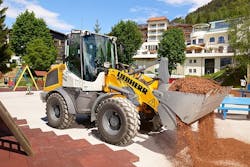Liebherr Lifecycle Study IDs GHG Efficient Drives
A study commissioned by the Liebherr Group suggests that when reducing greenhouse gas emissions on construction equipment, the most efficient drive system depends on the machine type.
Frontier Economics, a consulting firm, conducted a life cycle analysis of greenhouse gas emissions of typical construction machines equipped with various drive technologies. The firm determined how much CO2 arises from production to operation through to the recycling of the machines. This includes the mining and transport of the raw materials used in production of the equipment, the actual operation of the machine, and disposal and recycling.
It focused on mobile cranes, concrete mixers, and wheel loaders.
According to Liebherr, the purpose of the study was to comprehensively calculate the emissions of the machines and their drives in order to be able to recognize and assess how greenhouses gas emissions can be most effectively reduced.
“Emissions analyses are generally limited to the operating phase,” said Stephen Albrecht, member of the board of Liebherr-International AG, in a prepared statement. “This is not enough for our products because greenhouse gas emissions also occur in the upstream and downstream phases of construction machines’ lifecycles. To get a complete picture, we examined all stages of the life cycle, including the production of energy and provision of the infrastructure.”
These results are combined in a so-called product carbon footprint, which describes the emissions of a product throughout the entire life cycle.
What drive is most carbon neutral in construction equipment?
The three equipment types require different drive technologies in order to reduce as much emissions as possible due to their different performance requirements.
- For concrete mixers, electric drives make the biggest contribution to emissions reductions provided they use 100-percent renewable electricity for charging.
- For mobile cranes, operation with hydrotreated vegetable oil (HVO) shows the biggest savings potential. Important is that the HVO is certified to be produced from plant and food waste, for example, and does not contain palm oil. Hydrogen made from CO2 neutral sources follows in second place. In the long term, operation with hydrogen seems optimal as the availability of HVO in the vast quantities required cannot yet be predicted. However, until the required hydrogen infrastructure and drive technologies are mature, HVO delivers the best results as an interim technology, particularly in existing fleets with combustion engines.
- Wheel loaders should be operated either with a battery electric drive charged with renewable electricity or with e-fuels.
“The results of the life cycle analysis show that there is no uniform solution for climate-neutral drives of construction machines,” says Albrecht. Liebherr therefore relies on a technology neutral approach and can thus reduce emissions as much as possible depending on the machine and the application.
Liebherr markets a variety of construction equipment, and it plans to use the study results to compare various drive technologies. The smallest machines have a power output of 30 kW, the largest have a power output of more than 3,000 kW. All these machines must perform reliably in completely different conditions in diverse applications, according to Liebherr.
“A wheel loader on an urban construction site, for example, is exposed to different conditions than a mobile crane used in the construction of wind turbines,” said Albrecht. “The former can often be powered by electricity. In contrast, infrastructure projects in rural areas often lack the necessary power supply for an electrical connection. In addition, more energy is often required than can be provided with a battery-operated electric drive."
Based on the results of the life cycle analysis, Liebherr is in favor of adopting a technology-neutral approach in the transformation of the construction industry.
“Effective climate targets and incentives for the construction machinery sector must enable technological diversity so that the most environmentally friendly technology can be used depending on the performance requirements,” said Albrecht. In this light, battery electric should not be viewed as a universal solution, but as one important technology in the future drive mix, according to Liebherr. Apart from electric drives, Liebherr is also closely monitoring hydrogen, including the establishment of regulatory conditions for producing hydrogen and e-fuels, which are made from renewable sources
Source: Liebherr
